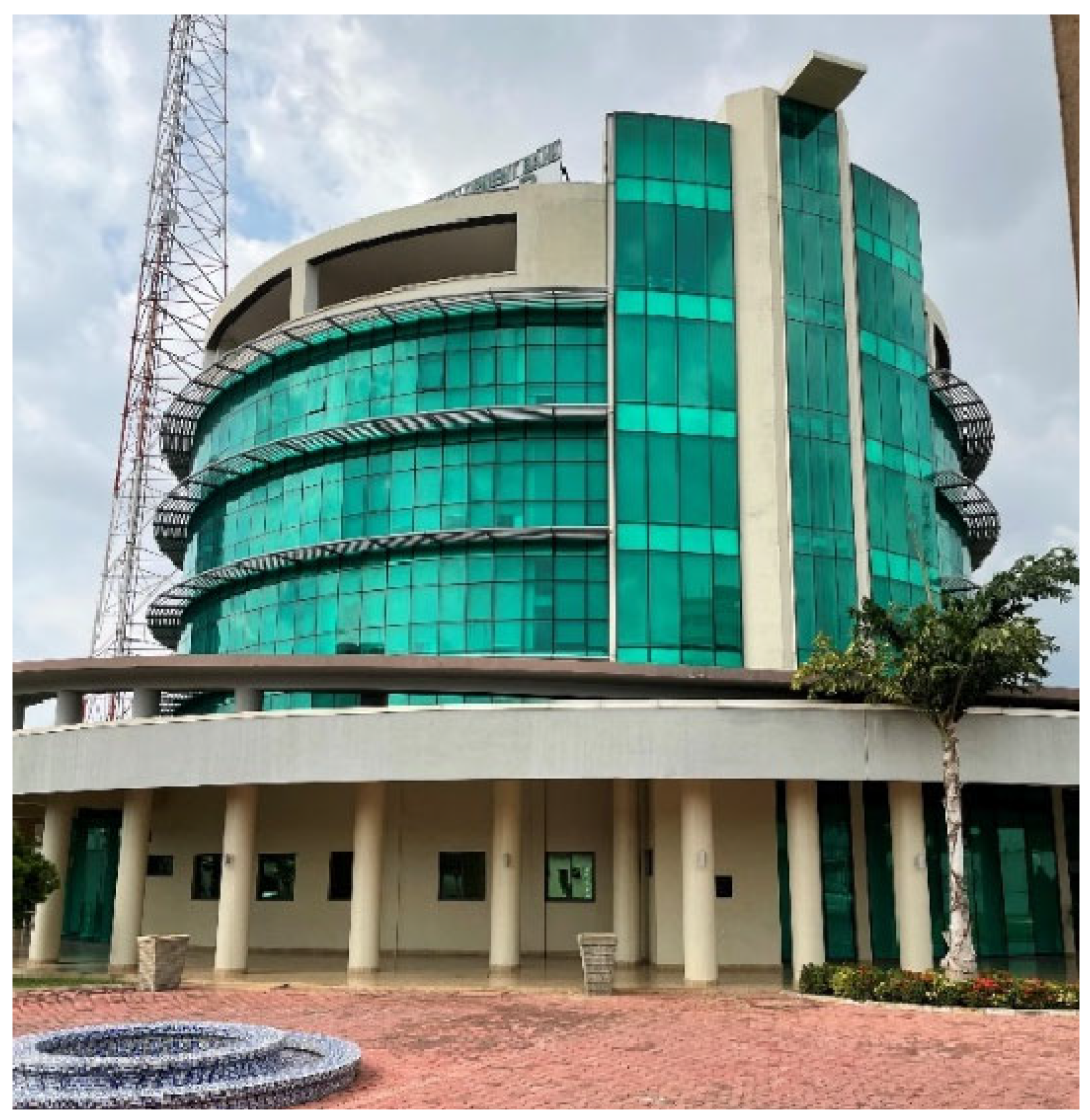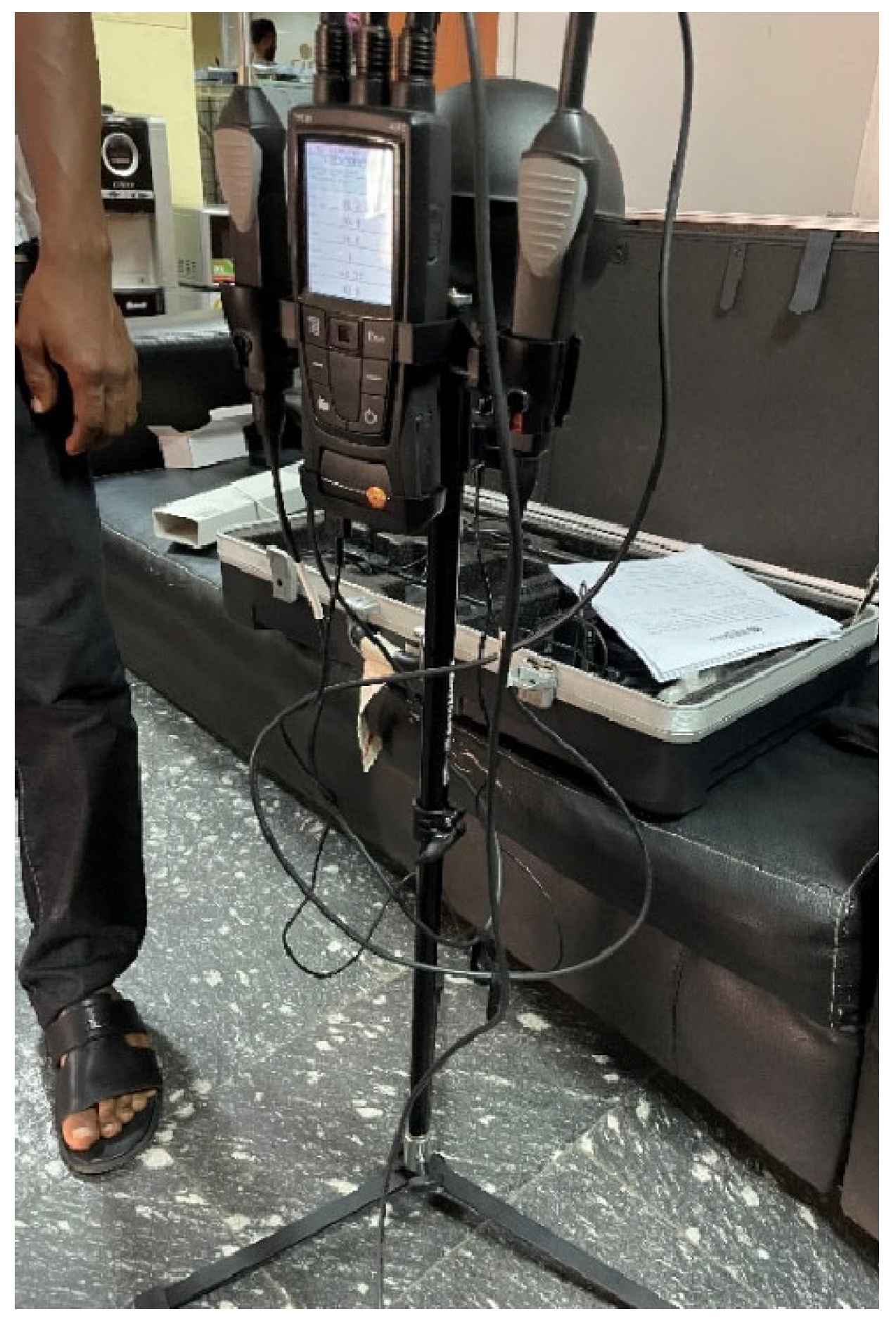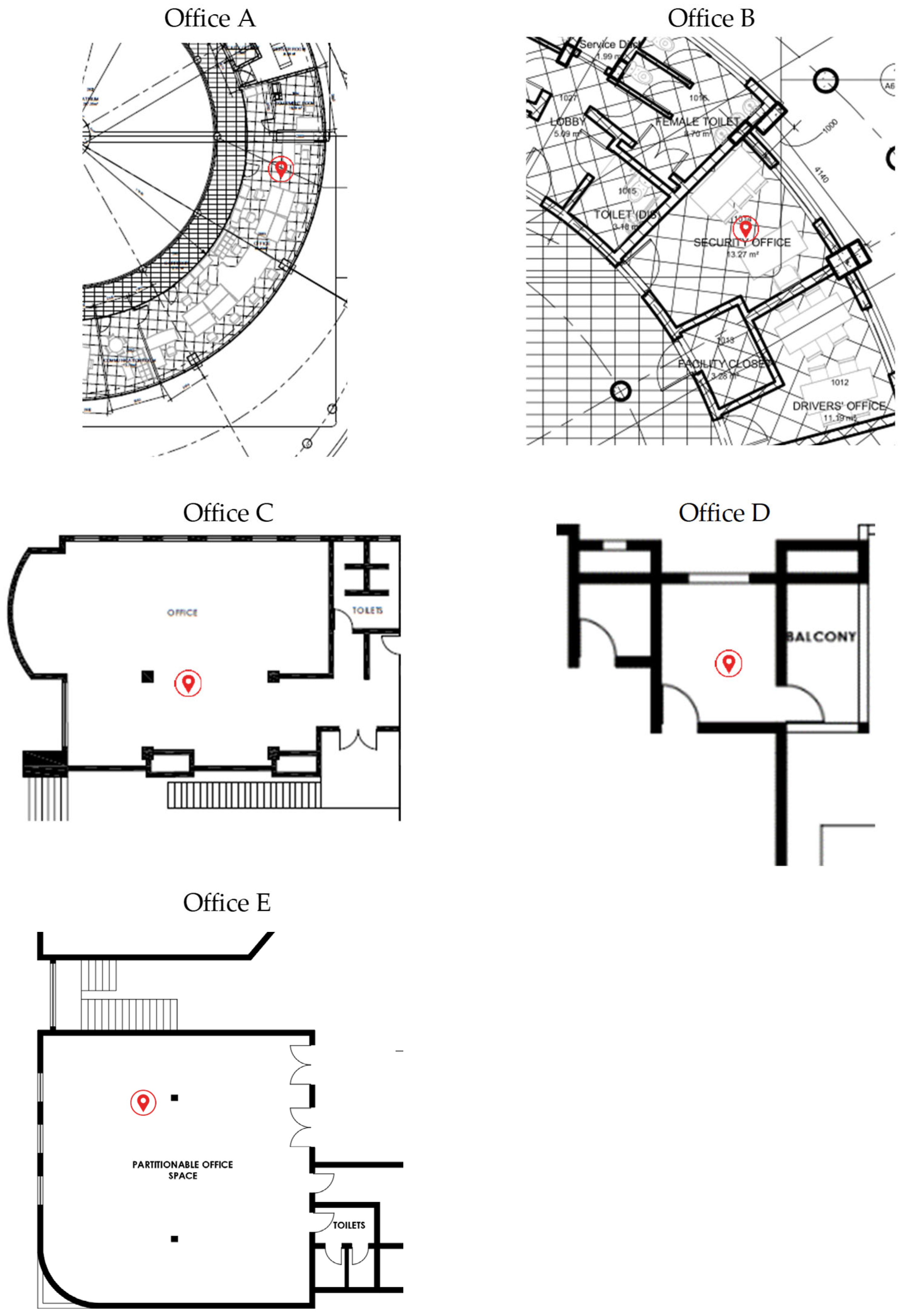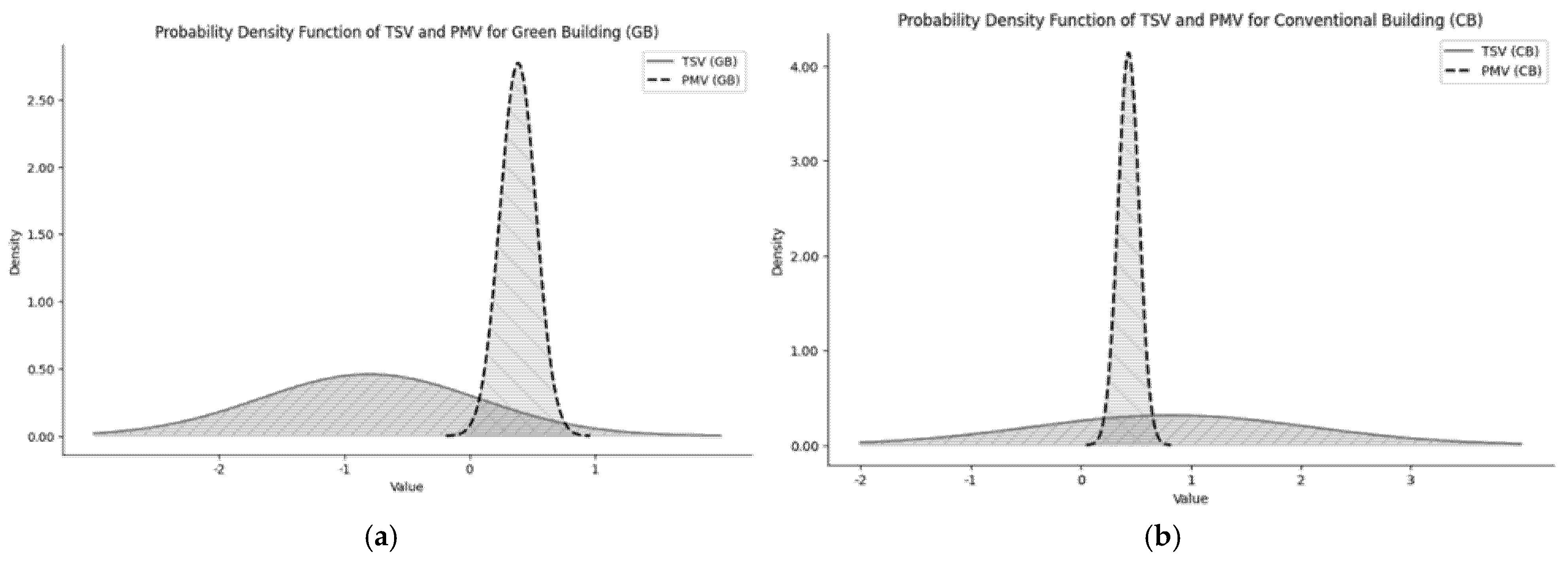Assessing Thermal Comfort in Green and Conventional Office Buildings in Hot Climates
Abstract
1. Introduction
1.1. Occupant Satisfaction in Green Office Buildings
1.2. Previous Thermal Comfort Studies on Office Buildings in Nigeria
- To compare occupant satisfaction with indoor thermal conditions in green-certified and conventional office buildings.
- To evaluate discrepancies between predicted and actual occupant perceptions of thermal comfort.
- To analyse the neutral temperature range in both building types based on thermal sensation responses.
2. Methods
2.1. Study Area
2.2. Buildings’ Description
2.3. Objective Measurements
2.4. Subjective Survey
2.5. Respondent Demographics and Work Context
3. Results
3.1. Predicted Mean Vote (PMV)
3.2. Thermal Sensation Votes (TSVs)
3.3. Comparison Between PMV and TSV
3.4. Neutral Temperature
- Tn is the neutral temperature,
- Top is the indoor operative temperature,
- TSV is the Thermal Sensation Vote,
- G is Griffiths’ constant (or regression coefficient).
4. Discussion
4.1. Discrepancy Between PMV and TSV
4.2. Potential for Energy Saving
5. Conclusions
Limitations and Recommendations
- Include a wider range of green-certified office buildings to increase the representativeness of green building performance across Abuja and similar tropical contexts.
- Longitudinal studies in investigating seasonal changes in thermal comfort and energy efficiency, hence serving a more holistic understanding of occupants’ preferences.
- Integrate adaptive and subjective models of thermal comfort to increase the correlation between predicted and actual occupant comfort, thus improving user satisfaction in building management.
- Investigate how adjusting the building systems based on the occupant feedback and TSV-aligned setpoints can further optimise energy savings and comfort.
Author Contributions
Funding
Institutional Review Board Statement
Informed Consent Statement
Data Availability Statement
Acknowledgments
Conflicts of Interest
Correction Statement
References
- Mukhtar, A.; Yusoff, M.; Ng, K. The potential influence of building optimization and passive design strategies on natural ventilation systems in underground buildings: The state of the art. Tunn. Undergr. Space Technol. 2019, 92, 103065. [Google Scholar] [CrossRef]
- Rafique, M.M.; Rehman, S. Renewable and Sustainable Air Conditioning. Sustainable Air Conditioning Systems; InTech: London, UK, 2018. [Google Scholar] [CrossRef]
- Kamath, S.; Soman, B.; Raj, A.; Kamath, S.; Kamath, R.; Kamath, L. Green Buildings: Sustainable Construction Principles. Int. J. Civ. Eng. Technol. 2019, 10, 1882–1892. [Google Scholar]
- Menadue, V.; Soebarto, V.; Williamson, T. The effect of internal environmental quality on occupant satisfaction in commercial office buildings. HVAC&R Res. 2013, 19, 1051–1062. [Google Scholar] [CrossRef]
- Harčárová, K.; Vilčeková, S. Indoor environmental quality in green certified office buildings. IOP Conf. Ser. Mater. Sci. Eng. 2022, 1252, 012054. [Google Scholar] [CrossRef]
- Altomonte, S.; Schiavon, S. Occupant satisfaction in LEED and non-LEED certified buildings. Build. Environ. 2013, 68, 66–76. [Google Scholar] [CrossRef]
- Wei, W.; Ramalho, O.; Mandin, C. Indoor air quality requirements in green building certifications. Build. Environ. 2015, 92, 10–19. [Google Scholar] [CrossRef]
- Licina, D.; Wargocki, P.; Pyke, C.; Altomonte, S. The future of IEQ in green building certifications. Build. Cities 2021, 2, 907–927. [Google Scholar] [CrossRef]
- Olagboye, S. Promoting Green Building Practices in Nigeria’s Construction Industry. Stats Metrics 2023. Available online: https://www.statsmetrics.ng/article/promoting-green-building-practices-in-nigeria-s-construction-industry (accessed on 21 October 2024).
- IFC Green Buildings Market Intelligence Nigeria Country Profile. n.d. Available online: https://edgebuildings.com/wp-content/uploads/2022/04/Nigeria-Green-Building-Market-Intelligence-EXPORT.pdf (accessed on 25 July 2025).
- Kim, H.G.; Kim, S.S. Occupants’ awareness of and satisfaction with green building technologies in a certified office building. Sustainability 2020, 12, 2109. [Google Scholar] [CrossRef]
- Lee, Y.S.; Kim, S.-K. Indoor Environmental Quality in LEED-Certified Buildings in the U.S. J. Asian Arch. Build. Eng. 2008, 7, 293–300. [Google Scholar] [CrossRef]
- Liang, H.-H.; Chen, C.-P.; Hwang, R.-L.; Shih, W.-M.; Lo, S.-C.; Liao, H.-Y. Satisfaction of occupants toward indoor environment quality of certified green office buildings in Taiwan. Build. Environ. 2014, 72, 232–242. [Google Scholar] [CrossRef]
- Mao, Y.; Zhu, K.; Zheng, Z.; Fang, Z. Evaluation of the thermal comfort in different commercial buildings in Guangzhou. Indoor Built Environ. 2024, 33, 391–413. [Google Scholar] [CrossRef]
- Nkini, S.; Nuyts, E.; Kassenga, G.; Swai, O.; Verbeeck, G. Evaluation of occupants’ satisfaction in green and non-green office buildings in Dar es Salaam-Tanzania. Build. Environ. 2022, 219, 109169. [Google Scholar] [CrossRef]
- Gou, Z.; Lau, S.S.-Y.; Chen, F. Subjective and Objective Evaluation of the Thermal Environment in a Three-Star Green Office Building in China. Indoor Built Environ. 2012, 21, 412–422. [Google Scholar] [CrossRef]
- Gou, Z.; Lau, S.S.Y. Post-occupancy evaluation of the thermal environment in a green building. Facilities 2013, 31, 357–371. [Google Scholar] [CrossRef]
- Lakhiar, M.T.; Sanmargaraja, S.; Olanrewaju, A.; Lim, C.H.; Ponniah, V.; Mathalamuthu, A.D. Evaluating and comparing objective and subjective thermal comfort in a malaysian green office building: A case study. Case Stud. Therm. Eng. 2024, 60, 104614. [Google Scholar] [CrossRef]
- Elnaklah, R.; Walker, I.; Natarajan, S. Moving to a green building: Indoor environment quality, thermal comfort and health. Build. Environ. 2021, 191, 107592. [Google Scholar] [CrossRef]
- Elnaklah, R.; Fosas, D.; Natarajan, S. Indoor environment quality and work performance in “green” office buildings in the Middle East. Build. Simul. 2020, 13, 1043–1062. [Google Scholar] [CrossRef]
- Paul, W.L.; Taylor, P.A. A comparison of occupant comfort and satisfaction between a green building and a conventional building. Build. Environ. 2008, 43, 1858–1870. [Google Scholar] [CrossRef]
- Altomonte, S.; Schiavon, S.; Kent, M.G.; Brager, G. Indoor environmental quality and occupant satisfaction in green-certified buildings. Build. Res. Inf. 2019, 47, 255–274. [Google Scholar] [CrossRef]
- Esfandiari, M.; Zaid, S.M.; Ismail, M.A.; Hafezi, M.R.; Asadi, I.; Mohammadi, S.; Vaisi, S.; Aflaki, A. Occupants’ satisfaction toward indoor environment quality of platinum green-certified office buildings in tropical climate. Energies 2021, 14, 2264. [Google Scholar] [CrossRef]
- Adebamowo, M.A.; Sangowawa, T.B.; Godwin, J. Low Energy Design of Buildings in the Tropics; The Case of Lagos, Nigeria. Int. J. Eng. Sci. (IJES) 2013, 2, 1–8. [Google Scholar]
- Jimoh, A.O.; Demenongu-Demshakwa, J. Establishing Indoor Comfort Temperature (Neutral Temperature) in Naturally Ventilated (NV) Office Buildings in Jos, Nigeria. J. Energy Technol. Policy 2020, 10, 39–50. [Google Scholar] [CrossRef]
- Jimoh, A.O.; Umar, A. Establishing Indoor Thermal Comfort Range for Office Buildings in Jos Nigeria Using the Adaptive Psychrometric Chart. Int. J. Energy Environ. Sci. 2021, 6, 151. [Google Scholar] [CrossRef]
- Musa, H.; Adamu, M.B.; Usman, A.J.; Abbas, S.E. Occupant’s Thermal Perception in Mixed-mode Office Buildings of the Tropical Climate. Adv. J. Sci. Technol. Eng. 2024, 4, 67–79. [Google Scholar] [CrossRef]
- Efeoma, M.O. The Influence of Clothing on Adaptive Thermal Comfort: A Study of the Thermal Comfort of Office Workers in Hot Humid Conditions in Enugu, Nigeria. Ph.D. Thesis, The University of Edinburgh, Edinburgh, Scotland, 2016. [Google Scholar]
- Kim, J.; de Dear, R.; Cândido, C.; Zhang, H.; Arens, E. Gender differences in office occupant perception of indoor environmental quality (IEQ). Build. Environ. 2013, 70, 245–256. [Google Scholar] [CrossRef]
- Meir, I.A.; Garb, Y.; Jiao, D.; Cicelsky, A. Post-occupancy evaluation: An inevitable step toward sustainability. Adv. Build. Energy Res. 2009, 3, 189–219. [Google Scholar] [CrossRef]
- Monfared, I.G.; Sharples, S. Occupants’ perceptions and expectations of a green office building: A longitudinal case study. Arch. Sci. Rev. 2011, 54, 344–355. [Google Scholar] [CrossRef]
- Esfandiari, M.; Zaid, S.M.; Ismail, M.A.; Aflaki, A. Influence of indoor environmental quality on work productivity in green office buildings: A review. Chem. Eng. Trans. 2017, 56, 385–390. [Google Scholar] [CrossRef]
- Thapa, S.; Bansal, A.K.; Panda, G.K. Thermal comfort in naturally ventilated office buildings in cold and cloudy climate of Darjeeling, India—An adaptive approach. Energy Build. 2018, 160, 44–60. [Google Scholar] [CrossRef]
- Carlucci, S.; Bai, L.; de Dear, R.; Yang, L. Review of adaptive thermal comfort models in built environmental regulatory documents. Build. Environ. 2018, 137, 73–89. [Google Scholar] [CrossRef]
- World Climate Guide. Abuja Climate Guide, Nigeria. Available online: http://www.worldclimateguide.co.uk/guides/nigeria/abuja/?units=metric&style=symbols (accessed on 26 September 2024).
- Abubakar, I.R. Abuja city profile. Cities 2014, 41, 81–91. [Google Scholar] [CrossRef]
- Adaji, M.U.; Adekunle, T.O.; Watkins, R.; Adler, G. Indoor comfort and adaptation in low-income and middle-income residential buildings in a Nigerian city during a dry season. Build. Environ. 2019, 162, 106276. [Google Scholar] [CrossRef]
- Cakó, B.; Zoltán, E.S.; Girán, J.; Medvegy, G.; Miklós, M.E.; Nyers, Á.; Grozdics, A.T.; Kisander, Z.; Bagdán, V.; Borsos, Á. An efficient method to compute thermal parameters of the comfort map using a decreased number of measurements. Energies 2021, 14, 5632. [Google Scholar] [CrossRef]
- Ali, T.M. Thermal Comfort Study on a Renovated Residential Apartment in Tjärna Ängar, Borlänge. Master’s Thesis, Dalarna University, Falun, Sweden, 2020. [Google Scholar]
- Oyinlola, M.; Beizaee, A.; Onyenokporo, N.; Takyie, E.G.; Adekeye, O.F. Thermal comfort perception of occupants in an upcycled bottle house in Abuja, Nigeria. In Proceedings of the 2nd International Conference on Construction, Energy, Environment & Sustainability, Funchal, Portugal, 27–30 June 2023. [Google Scholar]
- Dębska, L.; Krakowiak, J.; Kapjor, A. Modern methods of thermal comfort measurements. Struct. Environ. 2021, 12, 161–165. [Google Scholar] [CrossRef]
- ASHRAE. Thermal Environmental Conditions for Human Occupancy; ASHRAE Inc.: Atlanta, Georgia, 2010. [Google Scholar]
- Hoyt, T.; Schiavon, S.; Piccioli, A.; Cheung, T.; Moon, D.; Steinfeld, K. CBE Thermal Comfort Tool; Centre for the Built Environment, University of California: Berkeley, CA, USA, 2013. [Google Scholar]
- ASHRAE ANSI/ASHRAE Standard 55-2017; Thermal Environmental Conditions for Human Occupancy. ASHRAE Inc.: Atlanta, Georgia, 2017.
- ASHRAE. Thermal Environmental Conditions for Human Occupancy. ASHRAE Inc.: Atlanta, Georgia, 2004. [Google Scholar]
- ASHRAE. ASHRAE ANSI/ASHRAE Addendum d to ANSI/ASHRAE Standard 55-2017; ASHRAE Inc.: Atlanta, Georgia, 2020. [Google Scholar]
- Griffiths, I.D. Thermal Comfort Studies in Buildings with Passive Solar Features, Field Studies; Report to the Commission of the European Community; Commission of the European Communities: UK, 1990. [Google Scholar]
- Elnaklah, R. Impact of Indoor Environmental Quality on Occupant Satisfaction, Perceived Health, and Work Performance in “Green” Office Buildings in the Middle East. Ph.D. Thesis, University of Bath, Bath, UK, 2021. [Google Scholar]
- Humphreys, M.A.; Nicol, F.J. Outdoor Temperature and Indoor Thermal Comfort: Raising the Precision of the Relationship for the 1998 ASHRAE Database of Field Studies; ASHRAE Inc.: Atlanta, Georgia, 2003. [Google Scholar]
- Humphreys, M.; Rijal, H.; Nicol, J. Updating the adaptive relation between climate and comfort indoors; new insights and an extended database. Build. Environ. 2013, 63, 40–55. [Google Scholar] [CrossRef]
- Nicol, F.; Humphreys, M.A.; Michael, A.; Roaf, S. Adaptive Thermal Comfort: Principles and Practice; Routledge: London, UK, 2012. [Google Scholar]
- Ryu, J.; Kim, J.; Hong, W.; de Dear, R. Defining the thermal sensitivity (Griffiths constant) of building occupants in the Korean residential context. Energy Build. 2020, 208, 109648. [Google Scholar] [CrossRef]
- Rupp, R.F.; de Dear, R.; Ghisi, E. Field study of mixed-mode office buildings in Southern Brazil using an adaptive thermal comfort framework. Energy Build. 2018, 158, 1475–1486. [Google Scholar] [CrossRef]
- Singh, M.K.; Ooka, R.; Rijal, H.B.; Takasu, M. Adaptive thermal comfort in the offices of North-East India in autumn season. Build. Environ. 2017, 124, 14–30. [Google Scholar] [CrossRef]
- Wang, Z.; Yu, H.; Jiao, Y.; Wei, Q.; Chu, X. A field study of thermal sensation and neutrality in free-running aged-care homes in Shanghai. Energy Build. 2018, 158, 1523–1532. [Google Scholar] [CrossRef]
- Singh, M.K.; Kumar, S.; Ooka, R.; Rijal, H.B.; Gupta, G.; Kumar, A. Status of thermal comfort in naturally ventilated classrooms during the summer season in the composite climate of India. Build. Environ. 2018, 128, 287–304. [Google Scholar] [CrossRef]
- Aghniaey, S.; Lawrence, T.M.; Sharpton, T.N.; Douglass, S.P.; Oliver, T.; Sutter, M. Thermal comfort evaluation in campus classrooms during room temperature adjustment corresponding to demand response. Build. Environ. 2019, 148, 488–497. [Google Scholar] [CrossRef]
- Nicol, F.; Humphreys, M. Derivation of the adaptive equations for thermal comfort in free-running buildings in European standard EN15251. Build. Environ. 2010, 45, 11–17. [Google Scholar] [CrossRef]
- Kiki, G.; Kouchadé, C.; Houngan, A.; Zannou-Tchoko, S.J.; André, P. Evaluation of thermal comfort in an office building in the humid tropical climate of Benin. Build. Environ. 2020, 185, 107277. [Google Scholar] [CrossRef]
- Kleber, M.; Wagner, A. Investigation of indoor thermal comfort in warm-humid conditions at a German climate test facility. Build. Environ. 2018, 128, 216–224. [Google Scholar] [CrossRef]
- Alnuaimi, A.; Natarajan, S. Extreme cold discomfort in extreme hot climates, a study of building overcooling in office buildings in qatar. J. Eng. Res. 2021, 18, 101–113. [Google Scholar] [CrossRef]
- Khattak, S.H.; Wright, A.; Natarajan, S. Flexible Future Comfort. Routledge Handbook of Resilient Thermal Comfort, 1st ed.; Routledge: London, UK, 2022. [Google Scholar]
- Hema, C.; Ouédraogo, A.L.S.-N.; Bationo, G.B.; Kabore, M.; Nshimiyimana, P.; Messan, A. A field study on thermal acceptability and energy consumption of mixed-mode offices building located in the hot-dry climate of Burkina Faso. Sci. Technol. Built Environ. 2024, 30, 184–193. [Google Scholar] [CrossRef]
- Al-Akhzami, F.; Al-Khatri, H.; Al-Saadi, S.; Alalouch, C. An assessment of the thermal conditions and users’ thermal adaptability in air-conditioned offices in a hot climate region. In Comfort at the Extremes 2023: The Book of Proceedings; CEPT University Press: Ahmedabad, India, 2024. [Google Scholar] [CrossRef]
- Abass, F.; Ismail, L.H.; Wahab, I.A.; Mabrouk, W.A.; Kabrein, H. Indoor thermal comfort assessment in office buildings in hot-humid climate. IOP Conf. Ser. Mater. Sci. Eng. 2021, 1144, 012029. [Google Scholar] [CrossRef]
- Alrebei, O.F.; Obeidat, B.; Al-Radaideh, T.; Le Page, L.M.; Hewlett, S.; Al Assaf, A.H.; Amhamed, A.I. Quantifying CO2 Emissions and Energy Production from Power Plants to Run HVAC Systems in ASHRAE-Based Buildings. Energies 2022, 15, 8813. [Google Scholar] [CrossRef]











| Author | Context | Climate | Conclusion |
|---|---|---|---|
| Liang et al. [13] | Taiwan | Hot humid | People working in green buildings were more satisfied with the thermal condition than those working in conventional buildings. |
| Elnaklah, Walker and Natarajan [19] | Jordan | Hot dry | Moving from a conventional office building to a green-certified building resulted in a significant increase in occupants’ thermal comfort. |
| Altomonte and Schiavon [6] | North America | N/A | Occupants of LEED-certified office buildings have equal satisfaction with IEQ as occupants of non-LEED-certified buildings. |
| Gou & Lau [17] | China | Subtropical | Occupants of green office building experience discomfort, caused by low temperatures in both summer and winter. |
| Lee and Kim [12] | United States | Continental | Occupant satisfaction with thermal conditions was greater in LEED-certified office buildings. |
| Elnaklah, Fosas and Natarajan [20] | Middle East | Hot dry | Thermal comfort is more in green office buildings than in conventional office buildings. |
| Menadue, Soebarto and Williamson [4] | Adelaide, Australia | Mediterranean | Green buildings offer slightly greater satisfaction in terms of thermal comfort. |
| Harčárová and Vilčeková [5] | Bratislava, Slovakia | Continental | Adequate thermal comfort can be anticipated in LEED-certified office buildings. |
| Paul and Taylor [21] | Albury-Wodonga, Australia | Humid continental | No difference in comfort perception between occupants of a green office building and those in non-green office buildings. |
| Nkini et al. [15] | Dar es Salaam, Tanzania | Hot humid | Occupants of green buildings reported dissatisfaction with temperature control, which they cited to be a result of overly cold air conditioning. |
| Altomonte et al. [22] | N/A | N/A | The green rating points and IEQ score of green-certified office buildings does not guarantee occupants’ satisfaction with the indoor environment. |
| Esfandiari et al. [23] | Malaysia | Hot humid | Although occupants reported overall satisfaction, overcooling was reported as a source of dissatisfaction. |
| Lakhiar et al. [18] | Malaysia | Hot humid | There are discrepancies between thermal comfort predicted by PMV model and occupants’ actual comfort levels. |
| Gou et al. [16] | China | Subtropical | Despite green certification, a significant proportion of green office building occupants complained about discomfort associated with thermal conditions. |
| Mao et al. [14] | Guangzhou, China | Subtropical | Green buildings provided better thermal comfort compared to non-green buildings. |
| Feature | GB | CB1 | CB2 | |
|---|---|---|---|---|
| Total floor area (m2) | 4500 | 6200 | 12,062 | |
| Number of floors | 5 | 8 | 6 | |
| Ventilation system | Air-conditioned | Air-conditioned | Air-conditioned | |
| Cooling and heating | Variable refrigerant flow system (VRF) | Wall split AC | Wall split AC | |
| Lighting fixtures | LED lights with PIR sensors | Fluorescent | Fluorescent | |
| Window operation | Operable | Operable | Operable | |
| Temperature control | Centrally controlled | Operable | Operable | |
| Lighting control | PIR sensors | Operable | Operable | |
| Energy supply | Grid + Diesel generator + Solar | Grid + Diesel generator | Grid + Diesel generator | |
| Construction details | Walls | Sandcrete block wall | Sandcrete block wall | Sandcrete block wall |
| Ground floor | Concrete floor | Concrete floor | Concrete floor | |
| Intermediate floors | Concrete slab | Concrete slab | Concrete slab | |
| Roof | Concrete roof | Concrete roof | Aluminium roof | |
| Glazing | Double glazing | Single glazing | Single glazing | |
| A | B | C | D | E | |
|---|---|---|---|---|---|
| Building | GB | GB | CB1 | CB1 | CB2 |
| Office type | Open plan | Shared office | Open plan | Shared office | Open plan |
| Occupancy | 15 | 3 | 21 | 2 | 18 |
| Size (m2) | 86.33 | 13.27 | 102 | 14.5 | 100 |
| GB | CBs | ||
|---|---|---|---|
| Air temperature | Mean | 23.4 | 24.4 |
| (°C) | STD | 0.6 | 0.23 |
| Min. | 22.4 | 23.7 | |
| Max. | 24.8 | 24.6 | |
| Mean radiant temperature (°C) | Mean | 24.8 | 25.7 |
| STD | 0.38 | 0.08 | |
| Min. | 24.1 | 25.5 | |
| Max. | 25.6 | 25.8 | |
| Relative Humidity (%) | Mean | 42.4 | 39 |
| STD | 0.7 | 7.9 | |
| Min. | 41.3 | 28.1 | |
| Max. | 44.1 | 59.7 | |
| Air velocity (m/s) | Mean | 0.01 | 0.01 |
| STD | 0.015 | 0.007 | |
| Min. | 0.01 | 0 | |
| Max. | 0.07 | 0.03 | |
| Predicted Mean Vote (PMV) | Mean | 0.28 | 0.5 |
| STD | 0.11 | 0.26 | |
| Min. | 0.06 | 0.03 | |
| Max. | 0.5 | 1.06 | |
| Predicted Percentage of Dissatisfied (PPD) (%) | Mean | 7 | 11.33 |
| STD | 1.25 | 6 | |
| Min. | 5 | 5 | |
| Max. | 10 | 29 | |
| GB | CB | ||
|---|---|---|---|
| Clothing insulation | Mean | 0.63 | 0.72 |
| STD | 0.02 | 0.17 | |
| Min. | 0.62 | 0.5 | |
| Max. | 0.7 | 1.19 | |
| Metabolic rates | Mean | 1.56 | 1.4 |
| STD | 0.2 | 0.22 | |
| Min. | 1.2 | 1.2 | |
| Max. | 2 | 2 | |
| GB | CB | ||
|---|---|---|---|
| Thermal sensation votes (TSV) | Mean | −1.07 | 0.56 |
| STD | 0.82 | 1.31 | |
| Min. | −2.00 | −2.00 | |
| Max. | 1 | 3 | |
| Building Type | TSV (Mean) | Top (Mean) | Tn |
|---|---|---|---|
| Green building (GB) | −1.1 | 24.3 °C | 26.5 °C |
| Conventional buildings (CBs) | 0.56 | 25.0 °C | 24.6 °C |
Disclaimer/Publisher’s Note: The statements, opinions and data contained in all publications are solely those of the individual author(s) and contributor(s) and not of MDPI and/or the editor(s). MDPI and/or the editor(s) disclaim responsibility for any injury to people or property resulting from any ideas, methods, instructions or products referred to in the content. |
© 2025 by the authors. Licensee MDPI, Basel, Switzerland. This article is an open access article distributed under the terms and conditions of the Creative Commons Attribution (CC BY) license (https://creativecommons.org/licenses/by/4.0/).
Share and Cite
Muhammad, A.H.; Taki, A.; Khattak, S.H. Assessing Thermal Comfort in Green and Conventional Office Buildings in Hot Climates. Sustainability 2025, 17, 7078. https://doi.org/10.3390/su17157078
Muhammad AH, Taki A, Khattak SH. Assessing Thermal Comfort in Green and Conventional Office Buildings in Hot Climates. Sustainability. 2025; 17(15):7078. https://doi.org/10.3390/su17157078
Chicago/Turabian StyleMuhammad, Abdulrahman Haruna, Ahmad Taki, and Sanober Hassan Khattak. 2025. "Assessing Thermal Comfort in Green and Conventional Office Buildings in Hot Climates" Sustainability 17, no. 15: 7078. https://doi.org/10.3390/su17157078
APA StyleMuhammad, A. H., Taki, A., & Khattak, S. H. (2025). Assessing Thermal Comfort in Green and Conventional Office Buildings in Hot Climates. Sustainability, 17(15), 7078. https://doi.org/10.3390/su17157078







